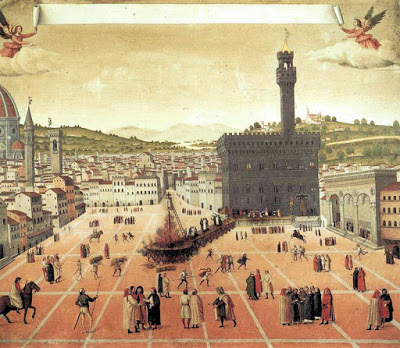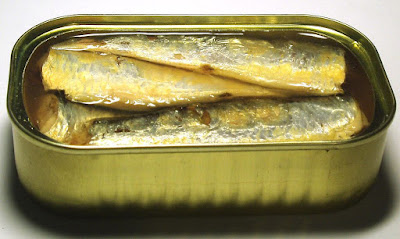Girolamo Savonarola was born on September 21, 1452 in Ferrara, which was the capital of the independent Duchy of Ferrara.
In these early years Girolamo wrote two poems which showed his anger at morally corrupt clergymen. The first "On the Ruin of the World", about the end of the world, was written when he was only 20. In "On the Ruin of the Church" written three years later, Savonarola singled out the papal court at Rome for special obloquy.
His grandfather was a very successful physician who oversaw his education and his family had hopes that Girolamo would follow in his grandfather's footsteps. He studied humanism and the classics but by the mid 1470s, he had abandoned his career intentions.
Girolamo Savonarola went to Bologna where on April 25, 1475 he knocked on the door of the Convent of San Domenico, of the Order of Friars Preachers, and asked to be admitted. Girolamo explained to his father in his farewell letter, he wanted to become a knight of Christ.
 |
| By Fra Bartolomeo - Florence, Museo di San Marco, |
In 1482 the Dominicans sent Savonarola to Florence, the ‘city of his destiny’, where he was assigned as lector, or teacher, in the Convent of San Marco in Florence. After five years, he went back to Bologna where he became 'master of studies’.
For the next several years Savonarola lived as an itinerant preacher with a message of repentance and reform in the cities and convents of north Italy.
He returned to Florence in 1490 to take up a position as Prior of San Marco. Savonarola became a popular preacher in Florence, 15,000 at a time flocked to hear him preach. His extravagant language was fired by his interpretations of the biblical doom-sayings of Ezekiel. The Dominican friar warned of a great judgement coming on the city after which a golden age would arise.
Charles VIII of France invaded Florence in 1494 with 60,000 men and modern innovative artillery made of bronze. The Medici rulers of Florence fled and Savonarola became the new leader of the city, both as a secular leader and priest. The popular preacher headed up a puritan moral dictatorship, reasoning that by making the Law of Christ the law of the land he was ushering in the reign of Christ on earth and the kingdom of the Holy Spirit.
Savonarola initiated tax reforms, aided the poor, reformed the courts and changed Florence from a lax, corrupt, pleasure-loving place into a virtual monastery.
One person who was influenced by Savonarola's powerful call to repentance was the artist Botticelli, who destroyed some of his earlier mythological paintings. He felt that when they were painted, he was unduly influenced by the worldly spirit of the age
On February 7, 1497, Savonarola organised a "bonfire of the vanities" at the carnival celebration before Lent, in which Florentine luxury goods, works of art, pornographic books, mirrors, cosmetics, musical instruments, fine dresses and gambling equipment were publicly burnt by his followers.
By the spring of 1497, Florence had become tired of Savonarola. During his Ascension Day sermon on May 4, 1497, groups of young men rioted in the streets, people began singing and dancing, and the taverns reopened. The riot became a revolution.
Savonarola had also been criticising the immorality of Pope Alexander VI and a week later, on May 13, 1497, the pope accused the Dominican friar of heresy and he was excommunicated.
By the following year, the pope was demanding his arrest and execution. On April 8, 1497 soldiers attacked the Convent of San Marco and after a bloody battle Savonarola's guards and religious supporters were killed. He surrendered and during the next few weeks was tortured to make him say that he was guilty of heresy, corruption, and other crimes against the Church.
On the morning of May 23, 1498, Savonarola, together with fellow friars Fra Silvestro and Fra Domenico da Pescia were led out into the main square where, before a tribunal of high clerics and government officials, they were condemned as heretics and sentenced to die forthwith. The three men were put on crosses and were burned alive. Savonarola died in the same place where he had burnt the paintings and books.
 |
| Painting (1650) of Savonarola's execution in the Piazza della Signoria |
Niccolò Machiavelli, author of The Prince, witnessed and wrote about the execution. The Medici soon retook control of Florence.
Savonarola was a hero to many of the early Protestants, who saw in his opposition to the papacy a useful example to follow.































